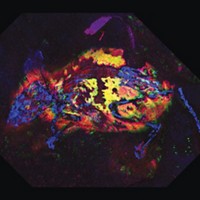Advertisement
Grab your lab coat. Let's get started
Welcome!
Welcome!
Create an account below to get 6 C&EN articles per month, receive newsletters and more - all free.
It seems this is your first time logging in online. Please enter the following information to continue.
As an ACS member you automatically get access to this site. All we need is few more details to create your reading experience.
Not you? Sign in with a different account.
Not you? Sign in with a different account.
ERROR 1
ERROR 1
ERROR 2
ERROR 2
ERROR 2
ERROR 2
ERROR 2
Password and Confirm password must match.
If you have an ACS member number, please enter it here so we can link this account to your membership. (optional)
ERROR 2
ACS values your privacy. By submitting your information, you are gaining access to C&EN and subscribing to our weekly newsletter. We use the information you provide to make your reading experience better, and we will never sell your data to third party members.
Environment
Isotope Fingerprints Help Researchers Pinpoint Source Of People’s Mercury Exposure
Environmental Analysis: Urine test can determine how much mercury came from a person’s dental work or their diet
by Naomi Lubick
March 26, 2013

To estimate people’s exposure to toxic mercury, environmental scientists often analyze hair and urine samples. A new study reports that by measuring ratios of mercury isotopes in urine samples, researchers could also distinguish between two common sources of mercury exposure: people’s dental fillings and the fish they eat (Environ. Sci. Technol., DOI: 10.1021/es305250z).
Some dental fillings, called amalgams, use inorganic elemental mercury because it is durable and easy for dentists to work with. Over the past few decades, scientists have debated how much inorganic mercury leaches from these fillings into people’s bodies and what health effects that mercury might cause.
But inorganic mercury isn’t as worrisome as methylmercury, an organic form of the metal. People ingest methylmercury when they eat tuna and other fish at the top of aquatic food webs, which accumulate the compound. The chemical ends up in human tissue and can cause developmental and neurological problems in children and fetuses.
Because people’s bodies expel inorganic mercury in urine and methylmercury accumulates in hair, scientists have used urine and hair samples to estimate the extent of the two exposure sources. But that strategy can be misleading because not all inorganic mercury in urine starts out that way. The human body can demethylate organic mercury and turn it into elemental mercury through a poorly understood mechanism. So what was once fish-borne methylmercury might end up looking like the inorganic form used to fill holes in teeth.
To better distinguish the sources of mercury exposure, Joel D. Blum, at the University of Michigan, Ann Arbor, and his colleagues turned to isotope analysis. For more than a decade, Blum has been developing methods to pinpoint the sources of mercury in the environment based on the ratios of the metal’s seven isotopes. In previous studies, his team has found that mercury mined from the earth and then used in dental amalgams has a slightly different isotopic fingerprint than that of mercury that has moved through the environment, such as the metal in fish flesh.
The difference stems from sunlight-triggered photochemical reactions that change the abundance of certain mercury isotopes. As a result, the well-traveled mercury in fish, which has had more sun exposure than the mined mercury, has slightly larger 199Hg-to-202Hg and 201Hg-to-202Hg ratios than amalgam mercury does.
Laura S. Sherman, one of Blum’s postdoctoral researchers, wanted to see if she could spot this subtle difference in people’s urine. Using inductively-coupled plasma mass spectrometry, she and her colleagues measured the amounts of each mercury isotope in the hair and urine of about a dozen dentists and dental hygienists. The urine samples’ 199Hg-to-202Hg and 201Hg-to-202Hg ratios suggest that dental fillings weren’t the dentists’ main source of exposure. The ratios actually closely matched those found in the dentists’ hair samples and data collected in tuna fish flesh. The researchers concluded that about 70% of the dental workers’ mercury came from their diet.
Blum and his team hope epidemiologists studying mercury exposure in people will start to use the isotope analysis technique.
This study is the first to use isotope analysis of urine samples to pinpoint mercury exposure sources, says Laure Laffont of Paul Sabatier University, in Toulouse, France. She would like to use the method in her studies of mercury exposure in artisanal gold miners who use the inorganic form to separate gold from rocks that they dig up.






Join the conversation
Contact the reporter
Submit a Letter to the Editor for publication
Engage with us on Twitter